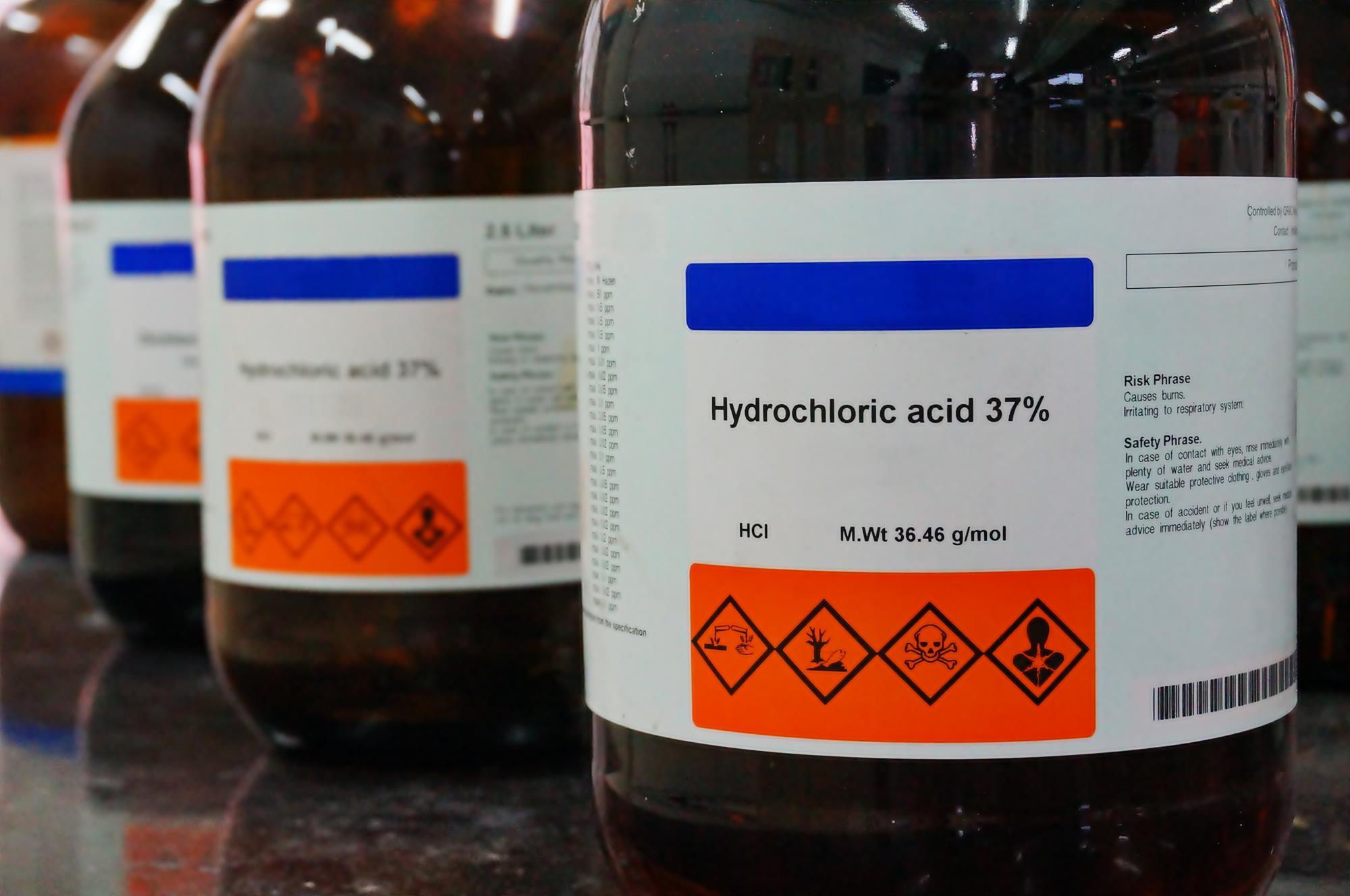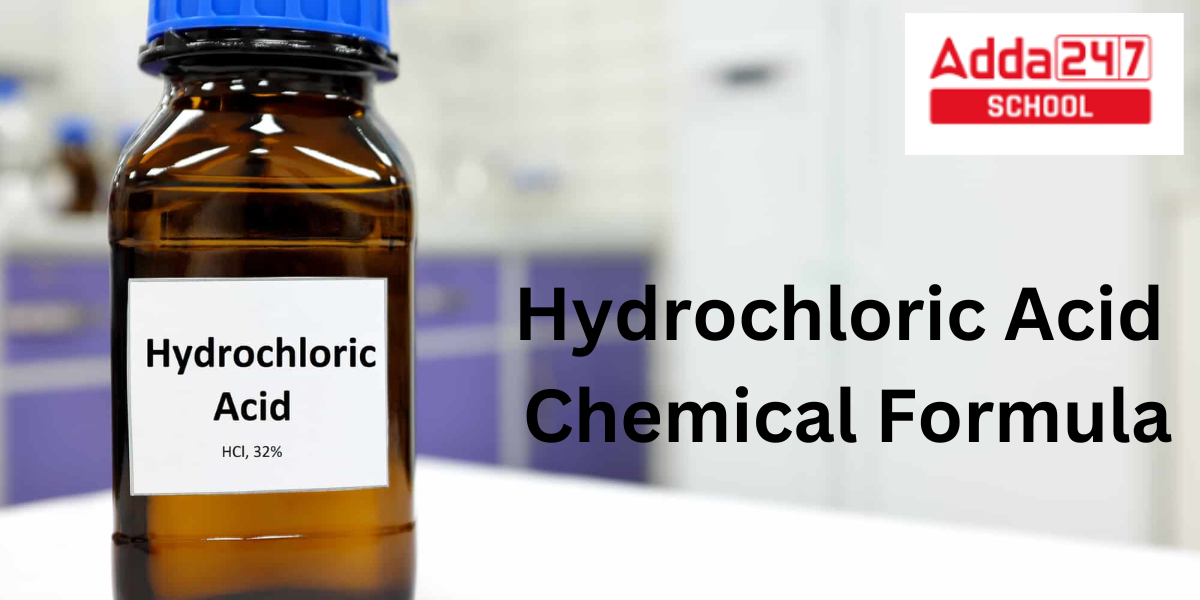Hydrochloric acid (HCl) is a strong, corrosive acid commonly used in laboratories and various industrial processes. Composed of hydrogen and chlorine, it is a clear, colorless liquid with a sharp, pungent odor. HCl plays a crucial role in chemical reactions, particularly in the production of chlorides, fertilizers, and dyes. Its acidic properties make it essential in pH regulation, metal processing, and food production, where it aids in digestion and preserves food. Despite its widespread use, HCl must be handled with care due to its highly reactive nature and potential health hazards, necessitating proper safety measures in its applications. Check out HCL Chemical Name and its full form below in the article.
HCL- Hydrochloric Acid
An aqueous solution of hydrogen chloride is what is known as hydrochloric acid, commonly referred to as muriatic acid. It has an unmistakably strong odour and is colourless. It is categorized as a powerful acid. In the digestive tracts of the majority of animal species, including humans, it is a part of the stomach acid. A crucial industrial chemical and reagent for laboratories is hydrochloric acid.
HCL Full form in Chemistry
In chemistry, HCl stands for hydrochloric acid. It is a strong acid that is commonly used in various industrial and laboratory applications.
Hydrochloric Acid Formula
The Chemical Formula of Hydrochloric Acid is HCl. Hydrochloric Acid molecule contains one atom of Hydrogen and one atom of Chlorine, hence its Chemical Formula is HCl.
Hydrochloric Acid Chemical Formula
The chemical formula for hydrochloric acid is HCl. It consists of one hydrogen atom (H) bonded to one chlorine atom (Cl).
What is Electron Configuration of elements?
HCL Chemical Name
HCL typically stands for “Hydrochloric Acid.” Its chemical formula is HCl, representing a strong acid composed of one hydrogen atom (H) and one chlorine atom (Cl). Hydrochloric acid is a corrosive and highly reactive chemical commonly used in various industrial and laboratory applications. It’s also found naturally in the human stomach, where it plays a crucial role in digestion.
Hydrochloric Acid HCL Density
The substance’s mass per unit of volume is known as its density (volumetric mass density or specific mass). The Density of Hydrochloric Acid (HCl) is 1.2 g/mL at 25 °C.
Hydrochloric Acid Uses
Strong inorganic acid hydrochloric acid is employed in numerous industrial operations, including the refinement of metal. The desired product quality is frequently determined by the application. In industrial organic chemistry, hydrogen chloride rather than hydrochloric acid is utilized more frequently.
Pickling of steel
In order to remove rust or iron oxide scale from iron or steel before undergoing further processing, such as extrusion, rolling, galvanizing, and other methods, pickling steel is one of the most significant uses of hydrochloric acid. The most used pickling agent for carbon steel grades is technical quality HCl, which is typically 18% concentrated.
Production of inorganic compounds
Hydrochloric acid is used to dissolve a variety of metals, metal oxides, and metal carbonates, similar to how it is used for pickling. Simplified formulae are frequently used to represent the conversion:
- Zn + 2 HCl → ZnCl2 + H2
- NiO + 2 HCl → NiCl2 + H2O
- CaCO3 + 2 HCl → CaCl2 + CO2 + H2O

pH control and neutralization
Using hydrochloric acid, you may control the pH (acidity) of your solution.
Regeneration of ion exchangers
Ion exchange resin regeneration uses top-notch hydrochloric acid. The process of demineralizing water by removing ions like Na+ and Ca2+ from aqueous solutions is known as cation exchange. The cations are removed from the resins using the acid.
Laboratory use
The hydrochloric acid is the monoprotic acid that is least likely to have an interfering oxidation-reduction process among the common strong mineral acids used in chemistry. Despite its acidity, it contains the non-reactive and non-toxic chloride ion, making it one of the least dangerous strong acids to work with. Solutions of intermediate grade hydrochloric acid are quite stable when stored and retain their concentrations over time.

Aluminium Chloride Formula-Definition, Structure, Uses, Properties
Hydrochloric Acid vs Hydrofluoric Acid
The main distinction between hydrofluoric acid and hydrochloric acid is that the latter is a strong acid while the former is a mild acid. Additionally, hydrofluoric acid has the ability to generate hydrogen bonds, whereas hydrochloric acid is unable to do so.
Hydrochloric Acid |
Hydrofluoric Acid |
| 1. Aqueous hydrogen chloride is hydrochloric acid. | 1. Hydrogen fluoride dissolved in water is hydrofluoric acid. |
| 2. Hydrochloric Acid has molar mass 36.5 g/mol | 2. Hydrofluoric Acid has molar mass 20 g/mol. |
| 3. It is a strong acid, and it cannot form hydrogen bonds. | 3. It is a weak acid, and it can form hydrogen bonds. |
| 4. Hydrochloric acid molecule has a chloride ion | 4. Hydrofluoric acid molecule has a fluoride ion |
What is Electron Configuration of elements?
Also Read:









 CBSE Admit Card 2026 for Private & R...
CBSE Admit Card 2026 for Private & R...
 AILET 2026 AIR 1: Check Full Toppers Lis...
AILET 2026 AIR 1: Check Full Toppers Lis...
 AILET Result 2026 OUT, How to Download S...
AILET Result 2026 OUT, How to Download S...














